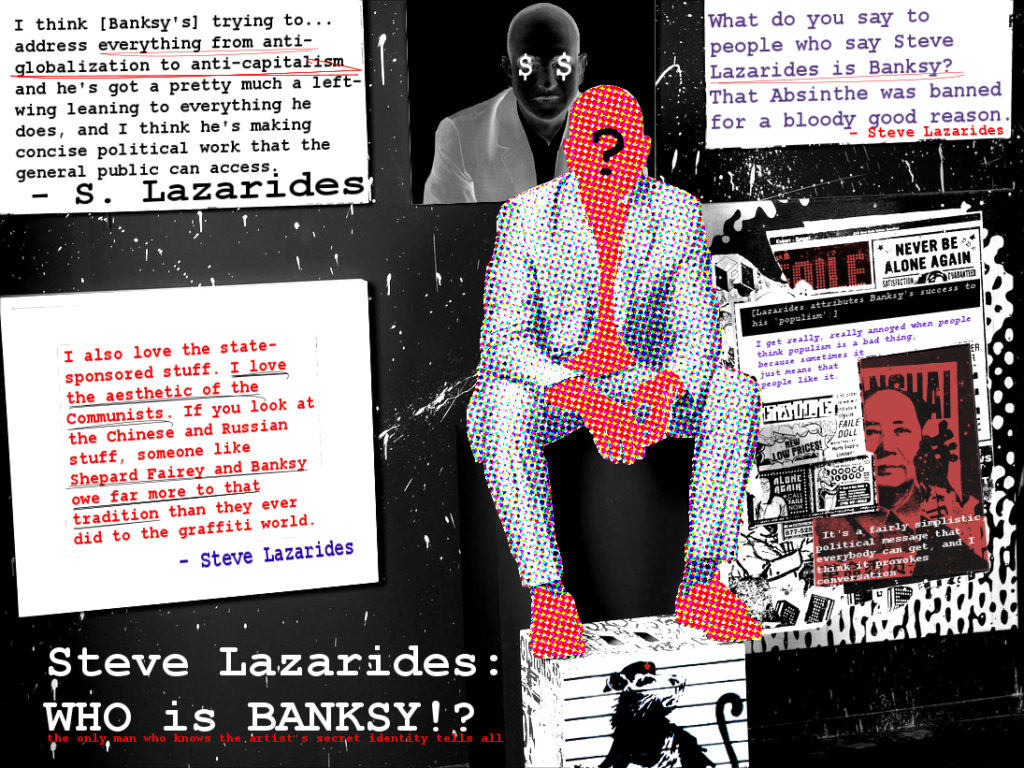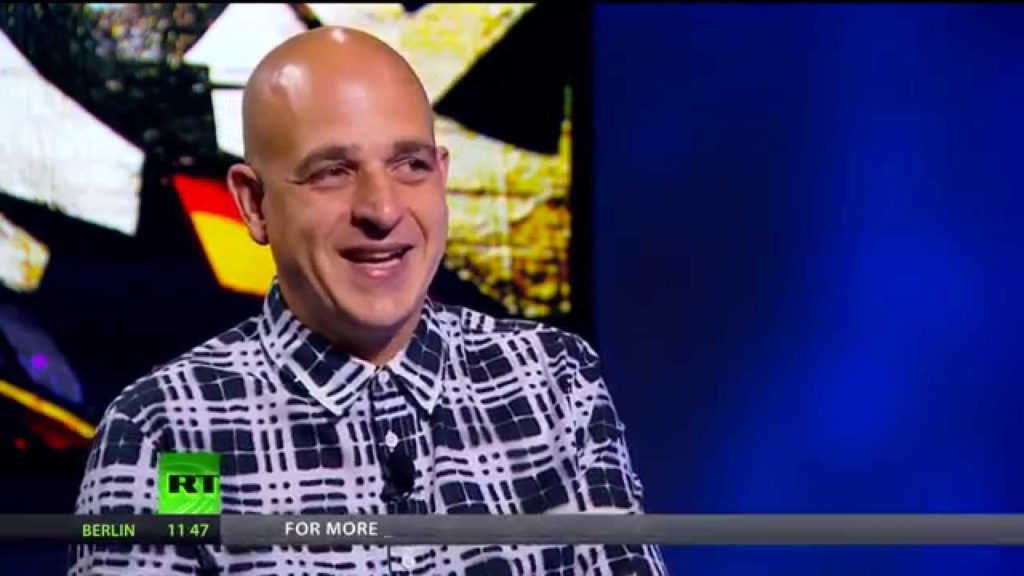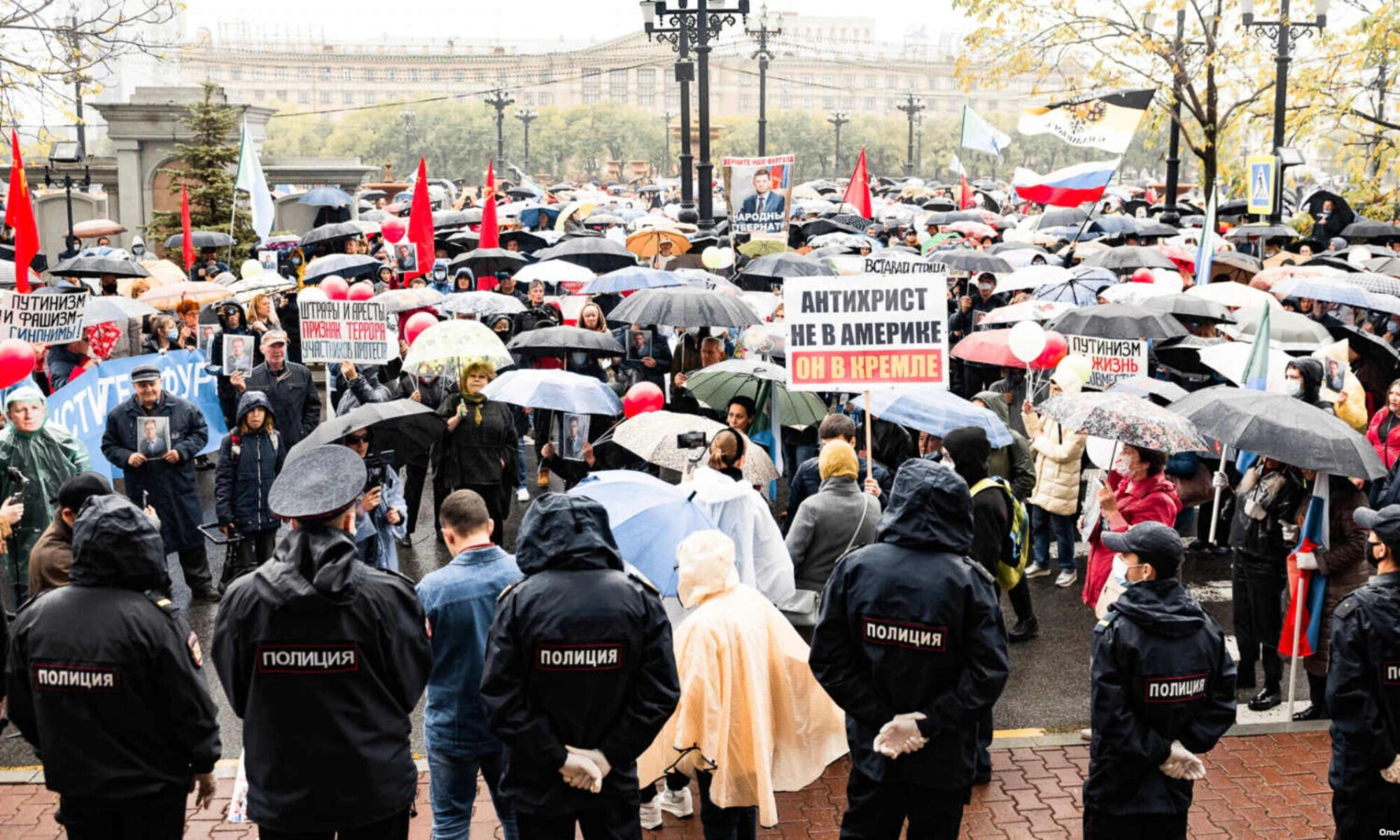
Admittedly, it probably only took me 20 minutes to come to the conclusion that Banksy’s true identity is most likely that of his former manager and ‘right hand man’ Steve Lazarides. At least I am not the only one (conspiracy theorist) to wonder about the apparently obvious.
“Banksy is so intimately tied to Lazarides’s success, and Lazarides to his, that, of people who care about these things, more than one has speculated that Lazarides is Banksy.” (New Yorker, 2007)
Lazarides inconsistently claims to not have had contact with the anonymous and secretive artist for years (in 2016 he claimed it had been over a year, and in 2018 over a decade), but continues to profit greatly from an association and his private collection of Banksy works. It seems parsimonious that with Lazarides being the only conduit to Banksy (and so profitably) for many years – that Banksy might be Lazarides’ (Absinthe-fueled) alter ego. Lazarides originally covered Banksy as a photographer for ‘Sleaze Nation’ magazine like some ‘Peter Parker’ (Spiderman) or ‘Clark Kent’ (Superman) figure might cover their ‘alter ego’.

As an artist, Banksy is seen to be inspired by “various political and social themes, including anti-war, anti-consumerism, anti-fascism, anti-imperialism, anti-authoritarianism, anarchism, nihilism, and existentialism.”He has been directly and financially connected to both Pussy Riot and Voina; who I have previously touched on as potential elements of Russian information warfare. In addition, he’s been a strong advocate of the positions of Edward Snowden, who clearly needs no introduction in terms of his strategic alignment with Russian interests.
In a thematic sense, Banksy’s oeuvre when considered as radical socialist propaganda is also quite similar to that of Orson Welles. Welles never identified openly as a Communist, but he was a radical anti-authoritaran and anti-fascist whose art was closely aligned with themes in Russian propaganda, and he was very close to known Russian spies, like Michael Olian and Louis Dolivet – not to mention at least an acquaintance of several other members of the Cambridge Five spy ring (Michael Straight and most likely H.P. Smolka too).
Banksy’s 2010 film “Exit Through the Gift Shop” is often seen in the context of an art mockumentary like the pioneering Orson Welles’ “F for Fake“. Moreover, Welles’ “War of the Worlds” is considered by some scholars to be the original English-language ‘mockumentary‘. (See also for a more detailed analysis of the genre and Banksy’s film.)
The hoax in F for Fake specifically related to the ability of a fake to take on the qualities of a real masterwork if it is a ‘good fake’ accepted by the art community; and especially if the forger’s work was so good the ‘real’ artist was tempted to claim it as his own.
https://www.youtube.com/watch?v=SJFkJ1h1wqw
Lazarides, who is a photographer, gallery owner, and pop up street artist by trade, says of Banksy’s approach: “He’s been using stencils for quite a long time, it was used a lot to get a political message out because it was so quick… in a way you never could with real graffiti”.
Armed with a knowledge of F for Fake, one must seriously wonder if ‘the spirit of Banksy’ has somewhat become a ‘real hoax’; in that even if a Banksy is not produced by the original artist (presumably Lazarides) — if Lazarides as the authoritative figure on Banksy legitimizes the work of a ‘forger’ who represents the appropriate political correctness, does that work become a “real” Banksy?
Certainly such a deception would be a poetic homage to F for Fake, as Exit Through the Gift Shop might be. Stenciling does not require tremendous technical proficiency — this is more about a quickly deployed postmodern style which contains a populist political message. Perhaps a ‘real’ Banksy is a kind of art rather than an individual artist today; not to say that Lazarides still won’t be the one to profit from it.
Another clue might even be the Banksy Print Gallery operated by Lazarides located next door to London’s Mondrian Hotel. Piet Mondrian was an artist who became a brand appropriated by other designers much like Bansky has become a commodified style (– not to mention Mondrian was a Theosophist influenced by the Marxist de stijl movement (via Bauhaus) and Wassily Kandinsky, potentially placing him close to Russia as well. See my thoughts on Theosophy here.).
Given so many ‘Marxist’ influences, a direct inspiration from classical Soviet (and Maoist) “state-sponsored” “Communist” propaganda, and connections to figures from Voina and Pussy Riot — who seem connected to Russia’s modern ‘nonlinear’ warfare — is Banksy too an actual asset, ‘fellow traveler’, or ‘useful idiot’ of Russia’s information offensive, regardless of whether his true identity is Steve Lazarides?
If Banksy is Lazarides’ alter-ego, it would seem that like most fellow travelers his best intentions for society are offset by his being an apparent dupe of a brutal authoritarian legacy.
